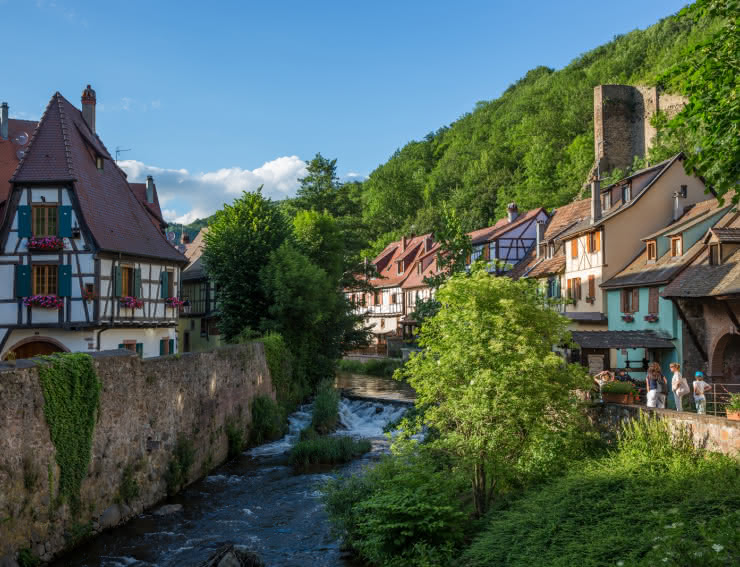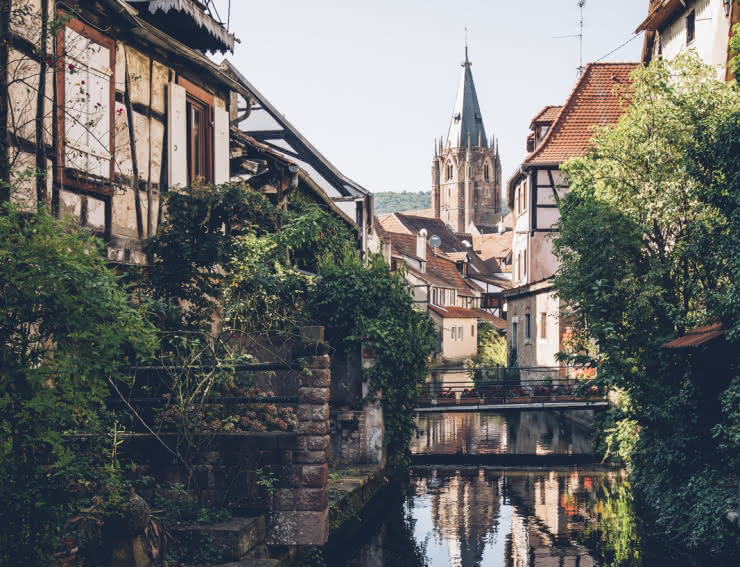
Alsace’s most beautiful wine-growing towns
Stop off in some of the most beautiful wine-growing towns and villages along the Alsace Wine Route! Nestling deep among the vineyards, the typical style of their buildings and their rich heritage make for a series of not-to-be-missed stops during your stay.
 ©Max Coquard - Best Jobers
©Max Coquard - Best JobersPretty Eguisheim
Situated just a few kilometres south of Colmar, the small medieval town of Eguisheim offers a halt packed with charm. Built in concentric circles, the village is great fun to roam as you always find yourself back where you started from. Walk the length of the town walls and admire the pretty, colourful half-timbered houses brimming with flowers, and read the ancient inscriptions on their lintels. The town’s heritage bears witness to a rich Christian history, for example with the Place du Château from where you can see the church dedicated to Pope Leo IX. While you are here, let yourself be tempted by some of the village’s lovely shops and wine cellars. Stop off at the village bakery and try the bretzels or sip a glass of Eichberg Grand Cru, star of the Eguisheim vineyards. Perhaps nature is more your thing? It’s easy to get out into the vineyards to admire the views across the plain: take one of the waymarked paths, on foot, on a segway or by bike, on your own or with one of the local guides.
Discover ©ART GE - Meyer
©ART GE - MeyerAuthentic Kaysersberg
Elected France’s Favourite Village in a television show competition in 2017, Kaysersberg’s appeal lies in unique heritage and incomparable atmosphere. It’s a lovely place to stroll around, taking in the charm of ornate half-timbered houses, its 13th-century church, its Renaissance town hall, not to mention its famous fortified bridge with views that plunge you right into a Grimm’s fairy tale. Up above the town, the ruins of an imperial castle stand proud in the midst of the vineyards. All that remains of the castle today is part of the perimeter wall and the main tower. You can climb its spiral stairway to enjoy an unusual view across the town’s rooftops to the surrounding countryside. Kaysersberg is not only full of character, it is also famous as the birthplace of Dr Albert Schweitzer, winner of the Nobel Peace Prize in 1952. The house where he was born is now a museum.
Discover ©31 Photography
©31 PhotographyRomantic Riquewihr
Nestling among the vineyards, the “little pearl of Alsace”, as Riquewihr is nicknamed, is an outstanding example of a medieval town. After surviving the wars untouched, it is packed with historic buildings and never fails to delight. Surrounded a double set of town walls dating from the 13th century, the village is dominated by the Dolder watch tower, which serves as the town emblem. On either side of the main street stand rows of magnificent half-timbered or stone buildings, some of which date back to the Middle Ages, others to the Renaissance, each one as attractive as the next. Continue your visit in the adjacent lanes, where you will find many other houses with some fine oriel windows. There are numerous wine-growing families in the village, some of which can trace their line back for 13 generations. Their wine cellars are odes to Alsatian wines in themselves, with their exceptional collections of large wine barrels. Head out of the village up the Geo Vino trail, which as it climbs up the hill offers a number of instructional stops to find out all about the local terroir. It culminates at a spot with lovely views over the village.
Discover ©Tristan Vuano
©Tristan VuanoMedieval Ribeauvillé
With a reputation as beautiful town that likes to party, Ribeauvillé envelopes you in a unique medieval atmosphere. There are plenty of marks left by time to remind you of the past. The town’s history is closely bound up with that of the Lords of Ribeaupierre, who have left many imprints on the place. Among the most impressive are the surprising Tour des Bouchers (Butchers’ Tower), which dominates the town centre, and three iconic castles situated on the hills around the town. Take advantage of a walk through the vineyards and forest to discover these impressive and admirably preserved historical remains. The Pfifferdaj is another thing that never seems to change in spite of passing time. Every year for over 600 years now, this fun, friendly festival offers the chance to enjoy traditions and costumes of the Middle Ages. A colourful event indeed!
Discover ©ART GE-Meyer
©ART GE-MeyerPoetic Thann
Huddled at the foot of the foothills to the Vosges, just a few kilometres from Mulhouse, Thann has much to discover: heritage, culture and traditions. Overlooked by the Château de l’Engelbourg, more commonly known as the “L’Œil de la Sorcière” (The Witch’s Eye), the old town is a maze of small lanes with Saint-Thiébaut collegiate church at its centre. The church is a jewel of Gothic architecture and you will be surprised by the details illustrating all the facets of the town’s history. And the southern gateway to the Alsace Wine Route also boasts its own renowned Grand Cru: the Rangen, the name of the only volcanic terroir in Alsace. The philosopher and writer Michel de Montaigne mentioned it in 1580: “We found hillsides full of vines, the finest and the best cultivated”. The vineyards on the steep hillsides require meticulous care. The grape harvest is a sight to see, with the grape pickers in harnesses and ropes to be able to collect the previous grapes.
Discover ©Lez Broz
©Lez BrozEclectic Obernai
Situated at a point where trading routes have crossed for centuries, Obernai owes its rich heritage to the taxes it levied on the traders that passed through the town. This explains the splendid half-timbered buildings and fine monuments including the belfry in the town centre. An iconic landmark, it watches proudly over the main square, which bustles with activity all year round. Obernai is a fortified town, partly encircled by ramparts, which today are a pleasant place to stroll while admiring views into private gardens. Each year in May the town hosts a circus festival called Pisteurs d’étoiles: another great reason to come and visit the town. One part of the vineyards overlooks the town, the other part extends out from it. For the best views over the town and the plain, take the Schenkenberg vineyard footpath.
Discover ©Studio Pygmalion
©Studio PygmalionSecret Mittelbergheim
Perched on a rocky headland in the middle of the vineyards, Mittelbergheim is a village with a singular history and architecture. With its remarkable unity of style, this small town has retained the character of a wine-growing village in the 17th and 18th centuries, where every stone has a story to tell. As you roam its streets and alleyways, you’ll see there are discreet signs highlighting all the points of interest in what is one of the “Most beautiful villages in France”. In the wine cellars, you can expect a cheerful, fraternal welcome. Their most precious asset is the terroir of the Zotzenberg hills, which produces Grands Crus that have made the name of Sylvaner grapes. A walk on the vineyard footpath on the hills around the village is a must to get the feel of the place. In spring, you can enjoy the very special spectacle of a rare flower in bloom: the wild tulip, with its striking golden-yellow colour. In summer, the village comes alive with a farmers’ market in the evenings, and at the end of July there is its famous wine festival.
Discover ©ART GE - Birgé
©ART GE - BirgéPicturesque Rosheim
Discover Rosheim at the foot of Mont Sainte-Odile with its unbelievably special architectural heritage. Situated at the crux of the Alsace Wine Route and the Romanesque Road, Rosheim is dotted with reminders of the Romanesque period. These include the Maison Romane (Roman esque House), which is considered as one of the oldest civilian buildings in Alsace. A few steps further and you find yourself in front of St Peter and St Paul’s church, a gem of Romanesque architecture. Dating from the 12th century, it features some magnificent sculpture, including a bestiary and decorated capitals. Look out for its hidden treasures! To find out more about Rosheim and its rich past, head out on the “Porte Bonheur, chemin des carrières” tourist greenway. It will take you through vineyards, fields and forests along a bucolic route between Rosheim and Saint-Nabor.
Discover ©Max Coquard - Best Jobers
©Max Coquard - Best JobersCultivated Wissembourg
Situated at the most northern tip of Alsace, on the border with Germany, Wissembourg has been the site of a convent since the 7th century. It was the monks who first planted and developed the vineyards. The vineyards surround seven villages in the Wissembourg area and are well worth exploring. The wineries have the particularity of being operated by Germans as well as French winegrowers. After stopping off at the Cleebourg cooperative to taste the wines or enjoying a walk on the footpaths through the vineyards, don’t miss the convent town of Wissembourg and in particular the Abbey of St Peter and St Paul. Then stroll through the town following the Lauter canals and admire its rich heritage. Stroll over to the Faubourg de Bitche as well, with its pretty half-timbered buildings that used to house the winegrowers’ guild, the most important in the town. The perfect time to visit Wissembourg is at Whitsuntide, when the town comes alive with three days of festivities.
Discover